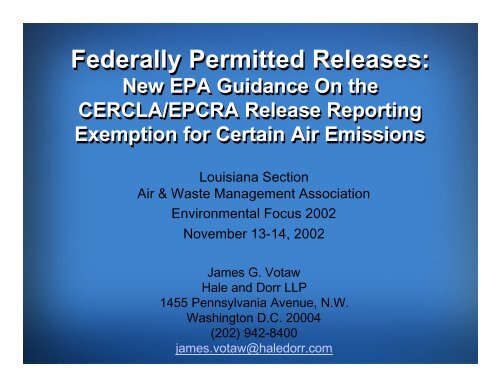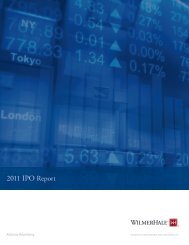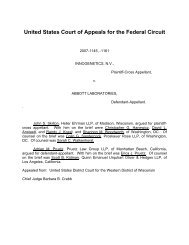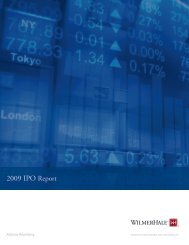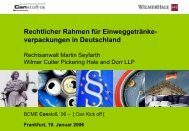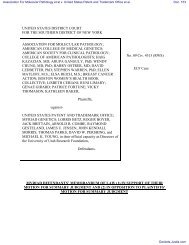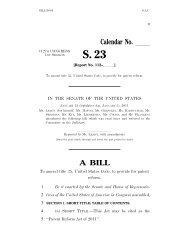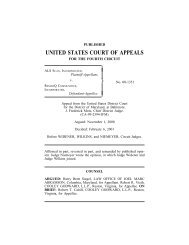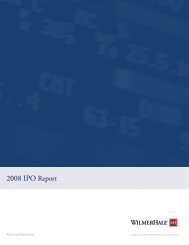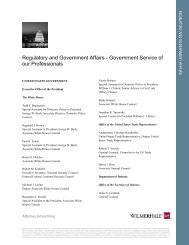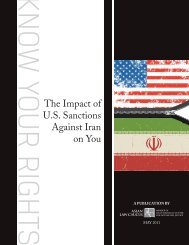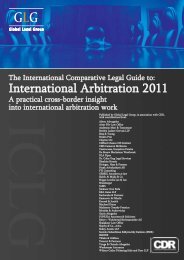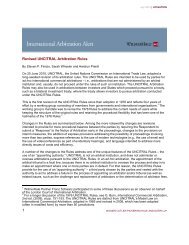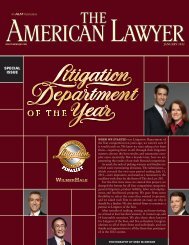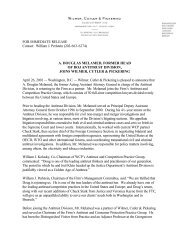Federally Permitted Releases - WilmerHale
Federally Permitted Releases - WilmerHale
Federally Permitted Releases - WilmerHale
- No tags were found...
Create successful ePaper yourself
Turn your PDF publications into a flip-book with our unique Google optimized e-Paper software.
“Guidance on the CERCLASection 101(10(H) <strong>Federally</strong><strong>Permitted</strong> Release Definition forCertain Air Emissions”• The FPR Guidance: 67 FR 18899 (Apr. 17, 2002)• Replaces an “interim” 1999 FPR Interim Guidance• Multi-industry coalition challenged the “interimguidance” in 2000‣ The National Association of Manufacturers, et al. v. U.S.EPA, No. 00-1111 (D.C. Cir.).‣ Industry coalition voluntarily dismissed its suit as part of anegotiated settlement which included the publication of therevised FPR guidance on April 17, 2002
Importance of the Scope ofthe FPR Exemption• Defines the Scope of an “Immediate”Reporting Requirement‣ 4 cascading violations‣ Potential criminal penalties‣ Both over-reporting and any enforcement actionmay trigger difficult community relations issues• Defines the Scope of CERCLA CostRecovery Liability‣ CERCLA §107(j) liability exemption‣ Not mentioned in the Guidance
CERCLA §101(10)(H)Statutory Definition of a “FPR”The term “federally permitted release’’ means: (H) anyemission into the air subject to a permit or control regulationunder § 111, § 112, title I part C, title I part D, or Stateimplementation plans [under] the Clean Air Act … includingany schedule or waiver granted, promulgated, or approvedunder these sections ....CERCLA §101(10)(H), 42 USC §9601(10)(H)
Control RequirementsAir Emissions Are Limited or Controlledin a Variety of Ways• Express emissions limits for specific pollutants• Express emissions limits for proxies• Technology requirements• Operational requirements• Work practices• See Senate Rep. 848, 96th Cong., 2d Sess. 49 (1980)
FPR Exemption Not Applicable• CAA Title V Operating Permits Controls †• CAA Title IV Acid Rain Controls †• CAA Title VI ODS Controls †• RCRA Organic Air Emissions Controls(i.e., subparts AA, BB, CC)• State-only rules ††Unless submitted for inclusion in the SIP
Legislative History of FPR Exemption• Intended to prevent overlapping reportingrequirements• Media and source specific reporting under CAA,CWA, RCRA, etc. more carefully tailored tohazards• To the extent the FPR exemption createdreporting “gaps,” EPA was to fill them with rulechanges in underlying programs (CAA, CWA,RCRA, etc.)‣ EPA has taken a different approach
FPR Chronology• 1980: FPR Exemption Appears in CERCLA• 1988: EPA proposes rule to “clarify” scope of FPRexemption• 1989: EPA amends proposed FPR definition• 1999: “Interim Guidance” Published• 2000: Litigation challenge to Interim Guidance filedInterim Guidance “Suspended” pending revisions• 2002: Final FPR Guidance published
The Final FPR Guidance
The Guidance Is Not a Rule• Agency emphasizes that the Guidance is not a rule• Not binding on EPA or the public• Provides notice of the Agency’s views• The affected public is free to challenge EPA’s viewson the scope of the FPR exemption in anysubsequent enforcement proceeding• As a practical matter – most companies will conformconduct to the Guidance
EPA’s FPR GuidanceThere is no Bright Line Test• Whether a particular Release is a FPR is acomplex question‣ There are no “bright line” tests‣ Determinations must be made on a case-by-casebasis‣ EPA will consider permits and permit applications,regulations, preambles and related agencybackground information documents• ∆ from Interim Guidance: No longer writtenlike a rule; Q&A format
Aspects of the FPR ExemptionAddressed by the Guidance• Applicability Issues Only‣ Characteristics of the Release‣ Characteristics of the underlying “Permit orControl Requirement”
Aspects of the FPR ExemptionAddressed by the Guidance• Compliance with underlying control requirement• Actual limitation or control of emissions• Treatment of NOx emissions• Treatment Accidents and Malfunctions• Treatment of VOC/PM Control requirements• Treatment of Minor Source thresholds• Grandfathered and other exempt sources• Treatment of Waivers
EPA’s Interpretation of theStatutory Definition of a “FPR”The term “federally permitted release’’ means: (H) onlythose certain emissions into the air that are anticipated anddo not result from an accident or malfunction, and are (i)subject to, (ii) in compliance with, and (iii) at the time of therelease, actually being controlled by (whether or not therelease is compliant) a permit or control regulation under §111, § 112, title I part C, title I part D, or Stateimplementation plans [under] the Clean Air Act, includingany schedule or waiver (but not an exemption) granted,promulgated, or approved under these sections ....CERCLA §101(10)(H), 42 USC §9601(10)(H)
EPA’s FPR GuidanceNOx Administrative ReportingExemption• RQs for NOx (NO and NO 2 ) are too low (10 lbs.)• In public comments, LEPCs and regulated communityidentified the low NOx RQ as a significant problem• Agency to create an administrative CERCLA/EPCRAreporting exemption for NOx air releases as soon asresources are available• In the interim, EPA will not enforce most CERCLA/EPCRANOx release reporting requirements• ∆ from Interim Guidance
EPA’s FPR Guidance“In Compliance with” a Prerequisite• To rely on the FPR exemption, a release must be “incompliance with” the relevant permit or controlregulation• Environmental Appeals Board’s 1994 decision in In reMobil Oil Corp., EPCRA Appeal No. 94–2, 5 EAB 490, 508, 1994WL 544260 (EAB, Sept. 29, 1994)• Requirement does not appear in the statutory FPRdefinition for air releases
EPA’s FPR GuidanceAccidents and Malfunctions• Generally: any unanticipated releases (resulting fromaccidents, fires, ruptures, wrecks or malfunctions) are notFPRs.‣ Even if the release does not constitute a violation oflaw‣ In re Borden Chemicals & Plastics, Co. (1993 ALJdecision)• Exception: If the “accidental” release is addressed inconformance with an enforceable accident or malfunctionplan that:‣ designed to limit HAP or criteria pollutant emissions‣ had actual effect of limiting the “accidental” emissions• ∆ from Interim Guidance
EPA’s FPR GuidanceIn re Borden Chemicals & Plastics, Co. †• A release can be an FPR only if the permit or controlregulation imposes an emission limit or otherwisecontrols the release.• ALJ found that an “unpreventable” vinyl chloriderelease from an emergency relief valve was not aFPR (regardless of whether the discharge violatedthe CAA), because the release was not “controlled”by the NESHAP regulation, but only made immunefrom an enforcement action† [CERCLA] EPCRA 003–1992 (Order Granting Partial Accelerated DecisionConcerning Liability (Feb. 18, 1993))
EPA’s Core Test of a FPR• Whether the particular release is subject to permitlimits and/or control regulations that:‣ Were specifically designed to limit or eliminate criteria orhazardous air pollutant emissions; and‣ Considered together, have the effect of limiting oreliminating emissions of the hazardous substance atissue.
EPA’s FPR GuidanceExemptions Based on VOC and PMControl Requirements• Controls on VOCs or PM (generically) are alsocontrols on any specific hazardous substances thatare constituents of the “controlled” VOC or PMemission; provided that…• The controls have the effect of limiting or eliminatingemissions of the constituent hazardous substance.• ∆ from Interim Guidance‣ Permits/Controls for VOCs/PM no longer required to be“specifically designed” to control hazardous impacts ofspecific constituent hazardous substances to be anFPR
EPA’s FPR GuidanceMinor Sources• Air releases from source exempt from NSPS, NESHAP,SIP or other CAA permitting or control requirements dueto their small annual volume may be FPRs -- if thereleases are subject to an enforceable threshold, which, ifexceeded, would trigger permit or other controlrequirements• Example: <strong>Releases</strong> of HAP from a minor HAP source (an“area source”) that is exempt from otherwise applicableMACT or NESHAP requirements due to low potential toemit• ∆ from Interim Guidance
EPA’s FPR GuidanceStart-Up, Shutdown and MalfunctionPlans• Air releases occurring in compliance with an approvedstart-up/ shut-down plan can qualify as FPRs, provided:‣ The Plan that contains federally enforceableprocedures; and‣ The required procedures effectively limit or control thereleases during start-up or shut-down (e.g., certainwork practices)• If air releases are simply exempt from controls duringstart-up and shut-down, in the Agency’s view, they are notFPRs
EPA’s FPR GuidanceFPR Exemptions Based on“Waivers”• The Statute: FPR “Permit or control requirements”include “schedule[s] or waiver[s] granted,promulgated, or approved under [CAA §§ 111, 112or SIPs]”• FPR Guidance:‣ NSPS innovative technology waivers are FPRs‣ Does not address any other “waivers” (e.g., site- orsource-specific “waivers” styled as exemptions)‣ An exemption from a control requirement cannot formbasis for a FPR
EPA’s FPR Guidance“Grandfathered” Sources• <strong>Releases</strong> in compliance with “grandfathering” exemptionsfrom control requirements are not (on that basis) FPRs• Generally, exemptions cannot form the basis for a FPR• Agency now acknowledges that “grandfathered” sourcesmay be subject to other air permit or control requirements,and emission may qualify as FPRs with respect to thoseother control requirements.• Note: FPR Guidance on grandfathered sources publishedseparately. “Guidance on the CERCLA Section 101(10)(H) <strong>Federally</strong> <strong>Permitted</strong>Release Definition for Clean Air Act ‘‘Grandfathered’’ Sources,” 67 FR 19750 (Apr. 23,2002).
Response to the FPR Guidance:Compliance Strategies
FPR Compliance Strategies• Assess Liability Exposure‣ Inventory emissions streams containing HS or EHS‣ Focus on (1) routine emissions and (2) foreseeablenon-routine emissions‣ Assess whether FPR applicable• Where Appropriate, Prepare to Claim FPR Exemption‣ As an exemption, burden of proof likely on company‣ Consider how to document conformance withGuidance and statute (e.g., compliance and actualcontrol)‣ Consider changes to procedures, permits, SSM plansand recordkeeping to buttress claim
FPR Compliance Strategies• Alternatives:‣ “Continuous Release” Reporting‣ Continue usual “Emergency” reporting• Balance risks and costs to select strategy‣ Prioritize action based on risk of triggeringarguably reportable release‣ Different emission streams may merit differentapproaches
Commentary on Guidance• Effective in giving notice of Agency’sgeneralized interpretations• Ineffective as compliance assistanceguidance in the context of an immediatereporting requirement• Many specifics not addressed• Agency positions (1) not entitled to deferencefrom courts, and (2) subject to substantialchallenge on the merits
Future Developments• Challenges to EPA’s interpretations inenforcement contexts• Case-by-case resolution of open issues leftby Guidance• Further rulemaking unlikely due to 1994 D.C.Circuit decision in Kelley v. EPA †† Kelley v. EPA, 15 F.3d 1100, reh’g denied, 25 F.3d 1088 (D.C. Cir 1994);cert, denied, 513 U.S. 1110 (1995).


